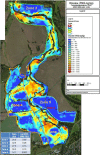Dioxin in the Elbe river basin: policy and science under the water framework directive 2000-2015 and toward 2021
- PMID: 27752444
- PMCID: PMC5044960
- DOI: 10.1186/s12302-016-0075-8
Dioxin in the Elbe river basin: policy and science under the water framework directive 2000-2015 and toward 2021
Abstract
A critical review of the last 25 years of dioxin policy in the Elbe river catchment is presented along seven main theses of the River Basin Community (RBC)-Elbe background document "Pollutants" for the Management Plan 2016-2021. In this period, polychlorinated dibenzodioxins/-furans (PCDD/Fs) and dioxin-like polychlorinated biphenyls (dl-PCBs) will play a major role: (i) as new priority substances for which environmental quality standards (EQSs) need to be derived (Directive 2013/39/EC); (ii) in the search for innovative solutions in sediment remediation (i.e., respecting the influence of mechanical processes; Flood Risk Directive 2007/60/EC); and (iii) as indicators at the land-sea interface (Marine Strategy Framework Directive 2008/56/EC). In the Elbe river catchment, aspects of policy and science are closely connected, which became particularly obvious in a classic example of dioxin hot spot contamination, the case of the Spittelwasser creek. Here, the "source-first principle" of the first cycle of the European Water Framework Directive (WFD) had to be confirmed in a controversy on the dioxin hot spots with Saxony-Anhalt's Agency for Contaminated Sites (LAF). At the Spittelwasser site, the move from "inside the creek" to "along the river banks" goes parallel to a general paradigm shift in retrospective risk assessment frameworks and remediation techniques for organic chemicals (Ortega-Calvo et al. 2015). With respect to dioxin, large-scale stabilization applying activated carbon additions is particularly promising. Another important aspect is the assessment of the ecotoxicology of dioxins and dl- PCBs in context of sediment mobility and flood risk assessment, which has been studied in the project framework FloodSearch. Currently, the quality goals of the WFD to reach a "good chemical status" are not met in many catchment areas because substances such as mercury do and others probably will (PCDD/Fs and dl-PCB) exceed biota-EQS values catchment area-wide. So far, relating biota-EQS values to sediment-EQSs is not possible. To overcome these limitations, the DioRAMA project was initiated, which has led to improved approaches for the assessment of dioxin-contaminated sediment using in vitro bioassays and to a robust dataset on the interrelation between dioxins and dioxin-like compounds in sediments and biota.
Keywords: Activated carbon; Biota-EQS; Bitterfeld region; Chemical status; Dredged materials; Flood risks; Marine strategy; NGOs; RBC Elbe; Sediment management concept.
Figures


Similar articles
-
A decision framework for possible remediation of contaminated sediments in the River Kymijoki, Finland.Environ Sci Pollut Res Int. 2009 Jan;16(1):95-105. doi: 10.1007/s11356-008-0061-9. Epub 2008 Oct 21. Environ Sci Pollut Res Int. 2009. PMID: 18941816
-
Vertical profile of PCDD/Fs, dioxin-like PCBs, other PCBs, PAHs, chlorobenzenes, DDX, HCHs, organotin compounds and chlorinated ethers in dated sediment/soil cores from flood-plains of the river Elbe, Germany.Chemosphere. 2007 Mar;67(3):592-603. doi: 10.1016/j.chemosphere.2006.09.065. Epub 2006 Nov 15. Chemosphere. 2007. PMID: 17109921
-
The Elbe flood in August 2002--occurrence of polychlorinated dibenzo-p-dioxins, polychlorinated dibenzofurans (PCDD/F) and dioxin-like PCB in suspended particulate matter (SPM), sediment and fish.Water Sci Technol. 2004;50(5):309-16. Water Sci Technol. 2004. PMID: 15497862
-
Effect-directed analysis of key toxicants in European river basins a review.Environ Sci Pollut Res Int. 2007 Jan;14(1):30-8. doi: 10.1065/espr2006.08.329. Environ Sci Pollut Res Int. 2007. PMID: 17352126 Review.
-
Part I: Integrated water quality management: river basin approach. Geochemical techniques on contaminated sediments--river basin view.Environ Sci Pollut Res Int. 2003;10(1):58-68. doi: 10.1065/espr2003.01.145. Environ Sci Pollut Res Int. 2003. PMID: 12635960 Review.
Cited by
-
Life cycle of PCBs and contamination of the environment and of food products from animal origin.Environ Sci Pollut Res Int. 2018 Jun;25(17):16325-16343. doi: 10.1007/s11356-018-1811-y. Epub 2018 Mar 27. Environ Sci Pollut Res Int. 2018. PMID: 29589245
-
Concentration of dioxin and screening level ecotoxicity of pore water from bottom sediments in relation to organic carbon contents.Ecotoxicology. 2021 Jan;30(1):57-66. doi: 10.1007/s10646-020-02318-w. Epub 2020 Dec 6. Ecotoxicology. 2021. PMID: 33280055 Free PMC article.
-
Reviewing the relevance of dioxin and PCB sources for food from animal origin and the need for their inventory, control and management.Environ Sci Eur. 2018;30(1):42. doi: 10.1186/s12302-018-0166-9. Epub 2018 Nov 1. Environ Sci Eur. 2018. PMID: 30464877 Free PMC article. Review.
-
Towards the review of the European Union Water Framework Directive: Recommendations for more efficient assessment and management of chemical contamination in European surface water resources.Sci Total Environ. 2017 Jan 15;576:720-737. doi: 10.1016/j.scitotenv.2016.10.104. Epub 2016 Oct 28. Sci Total Environ. 2017. PMID: 27810758 Free PMC article.
References
-
- Anonymous (2000) Directive 2000/60/EC of the European Parliament and the Council of 23 October 2000 establishing a framework for Community action in the field of water policy (Water Framework Directive). Official Journal of the EC, L327
-
- Anonymous Directive 2455/2001/EC of the European Parliament and of the Council of 20 November 2001 establishing the list of priority substances in the field of water policy and amending Directive 2000/60/EC. Off J Eur Commun. 2001;15:1–5.
-
- Von Hammerstein F, Lichtblau N (2015) ECJ ruling clarifies “deterioration” under Water Framework Directive. Law-Now—Your World First, 23.07.2015. http://www.cmslaw-now.com/ealerts/2015/07/ecj-ruling-clarifies-deteriora...
-
- RBC/FGG Elbe (2016) Aktualisierung des Bewirtschaftungsplans nach § 83 WHG bzw. Artikel 13 der Richtlinie 2000/60/EG für den deutschen Teil der Flussgebietseinheit Elbe für den Zeitraum von 2016 bis 2021. 259 p, FGG Elbe, Magdeburg, 22.11.2015. http://www.fgg-elbe.de/hintergrund-informationen.html (for all RBC/FGG-Elbe Documents)
-
- Anonymous (2008) Directive 2008/56/EC of the European Parliament and of the Council of 17 June 2008 establishing a framework for community action in the field of marine environmental policy (Marine Strategy Framework Directive). Off J Eur Union, L 164/19-164/40
LinkOut - more resources
Full Text Sources
Other Literature Sources
Molecular Biology Databases
Miscellaneous
